
Madison County is a county located in the U.S. state of Iowa. As of the 2020 census, the population was 16,548. The county seat is Winterset.

The Rock Island Centennial Bridge, officially the Master Sargeant Stanley W. Talbot Memorial Bridge, connects Rock Island, Illinois, and Davenport, Iowa. The bridge is 3,850 feet (1,173 m) long and stands 170 feet (52 m) above water level.

The Fort Madison Toll Bridge is a tolled, double-decked swinging truss bridge over the Mississippi River that connects Fort Madison, Iowa, and unincorporated Niota, Illinois. A double-track railway occupies the lower deck of the bridge, while two lanes of road traffic are carried on the upper deck. The bridge is about 1 mile (1.6 km) long with a swing span of 525 feet (160 m), and was the longest and largest double-deck swing-span bridge in the world when constructed in 1927. It replaced an inadequate combination roadway/single-track bridge completed in 1887. The main river crossing consists of four 270-foot (82 m) Baltimore through truss spans and a swing span made of two equal arms, 266 feet (81 m) long. In 1999, it was listed in the National Register of Historic Places under the title, Fort Madison Bridge, ID number 99001035. It was also documented as survey number IA-62 by the Historic American Engineering Record, archived at the Library of Congress. Construction and photographic details were recorded at the time in Scientific American magazine.

The Middle River is a tributary of the Des Moines River in south-central Iowa in the United States. It is 123 miles (198 km) long and drains an area of 489.5 square miles (1,268 km2). Via the Des Moines River, it is part of the watershed of the Mississippi River.

Cutler–Donahoe Bridge is a 79-foot-long (24 m) covered bridge in Madison County, Iowa. It was built in 1870 by Eli Cox. It originally crossed the North River near Bevington, Iowa. In 1979, the bridge was moved to its location at the entrance to the Winterset City Park.
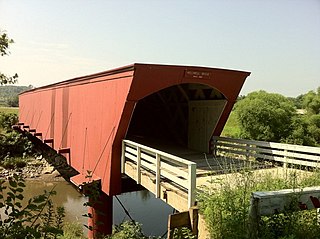
Holliwell Bridge is a wooden covered bridge in Madison County, Iowa. It was built over the Middle River in 1880 by Benton Jones.
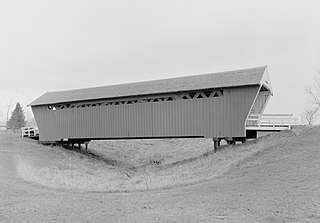
The Imes Bridge is a wooden covered bridge in Madison County, Iowa. Built in 1870, it was originally located over the Middle River. In 1887 it was moved to a spot over Clinton Creek, and in 1977 was moved again to its present site. It is 81 feet (25 m) long and is the oldest of the remaining covered bridges in Madison County. It was renovated in 1997 for a cost of $31,807.

The Bridgeport Bridge is a historic structure located near Denmark, Iowa, United States. This span was a replacement bridge for structure whose middle stone pier was deteriorating. The weaknesses in the old bridge were noted in 1887 and 1893. Both Des Moines and Lee counties financed the $5,110 construction of this bridge, which spans the Skunk River between the two counties. The 240-foot-long (73 m) Pennsylvania truss bridge was built in 1904 by the Clinton Bridge and Iron Works of Clinton, Iowa. It carried local traffic for nearly 90 years before it was closed. It has the distinction of being the longest pin-connected truss remaining in Iowa. The Bridgeport Bridge was listed on the National Register of Historic Places in 1998.

The Hogback Covered Bridge is a historic covered bridge near Winterset, Iowa. Named after a nearby limestone ridge, it was built in 1884 by Harvey P. Jones and George K. Foster over the North River on Douglas Township Road. The 106-foot-long (32 m) bridge was designed with a Town lattice truss system. It was built with steel pylons to support the main span.
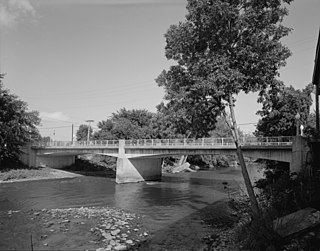
The Alden Bridge is a historic bridge in Alden, Iowa, which carries the town's Main Street over the Iowa River, United States. The concrete bridge is 150 feet (46 m) long and consists of two spans. It was built in 1936 to replace an earlier wooden bridge that had begun to deteriorate. The Weldon Brothers Construction Company supervised the bridge's construction, while the Iowa State Highway Commission designed the structure; it was one of the first bridges designed by the ISHC, which used similar plans for many other bridges in the state. Labor for the construction effort came from the Works Progress Administration, providing jobs for many of Hardin County's unemployed residents. The bridge was dedicated on July 4, 1936, as part of Alden's Independence Day celebrations.

The Mederville Bridge is a historic structure located in the unincorporated community of Mederville, Iowa, United States. It spans the Volga River for 156 feet (48 m). This is one of only a few open spandrel arch bridges constructed in Iowa. Designed by the Marsh Engineering Company of Des Moines, it replaced a covered timber Howe truss bridge. Clayton County rejected all of the original bids to build the structure when they all came in too high. Six companies bid a second time on the project, and F. E. Marsh and Company of Des Moines won. They completed in the bridge in 1918 for $17,454.32. It was listed on the National Register of Historic Places in 1998. On October 2, 2021, it was the site where Kelsey Bergan and Mark Schutte got married.

The Elkader Keystone Bridge is a historic structure located in Elkader, Iowa, United States. The old iron truss bridge that crossed the Turkey River at this location was declared unsafe in 1888. The Clayton County Board of Supervisors decided to construct a bridge of native limestone as way of saving money and providing a reliable crossing. Engineer M. Tschirgi designed the structure and Dubuque stonemasons Byrne and Blade constructed the bridge. It was built at a cost of $16,282, and spans the river for 346 feet (105 m). This is one of the largest twin arched keystone bridges west of the Mississippi River. A sidewalk was added on the north side of the structure in 1924. The bridge was individually listed on the National Register of Historic Places in 1976.

The Twin Bridge is a historic structure located in Twin Bridge Park southwest of Fayette, Iowa, United States. It spans the Little Volga River for 80 feet (24 m). The Fayette County Board of Supervisors contracted with N. M. Stark and Company of Des Moines to build almost all of its bridges between 1900 and 1913. This concrete Luten arch bridge was completed in about 1910 using a patented design by Indianapolis engineer Daniel Luten. Stark was a licensee for Luten and they built multiple bridges using his designs under a patent royalty agreement. The Twin Bridge was listed on the National Register of Historic Places in 1998.
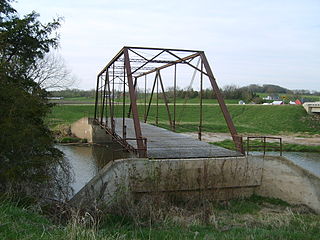
Mill Race Bridge is a historic structure located northwest of Eldorado, Iowa, United States. It spans the Turkey River for 120 feet (37 m). Its name is derived from its location near a riverside mill. Horace E. Horton, a civil engineer from Minneapolis, had designed wagon bridges for Fayette County in the 1880s. When he joined the Chicago Bridge & Iron Company late in the decade, he took the county with him as a client. Chicago Bridge & Iron was responsible for providing the county's bridges in the 1890s. This bridge was completed about 1892, but its concrete abutments are not original. While it remains in place, but it has been replaced by a newer span. The Mill Race Bridge was listed on the National Register of Historic Places in 1998.

West Auburn Bridge is a historic structure located northwest of West Union, Iowa, United States. It spans the Turkey River for 181 feet (55 m). In 1880 the Fayette County Board of Supervisors contracted with Minneapolis engineer Horace E. Horton to design and build this bridge. The Whipple through truss bridge was completed for $7,598.79. At the time of its nomination it was one of only eight bridges of this design known to exist in Iowa. The West Auburn Bridge was listed on the National Register of Historic Places in 1998.

Hale Bridge is a historic structure located south of Anamosa, Iowa, United States. It spans the Wapsipinicon River for 296 feet (90 m). It is an example of a bowstring through-arch truss bridge. Perhaps thousands of these bridges were built in Iowa in the late 1860s through the 1870s. However, by 1992, fewer than twenty survive.
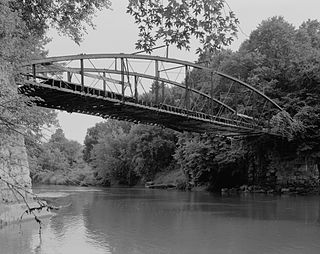
Corbett's/Eby's Mill Bridge is a historic structure located northeast of Scotch Grove, Iowa, United States. It spans the Maquoketa River for 128 feet (39 m). James S. Applegate established a gristmill near this location in 1858. He was joined by John Corbett, who obtained ownership by 1868 and expanded the operation and added a sawmill. He petitioned the Jones County Board of Supervisors for an iron bridge at this location in 1870. They agreed to pay two-thirds of the construction costs with the final third paid for by local subscriptions. The contract to construct this bridge and a similar span in Monticello was made with Miller, Jamison & Company of Cleveland. Both are single span bowstring truss bridges that were completed in November 1871. This bridge has always been identified with the mill. Samuel Eby acquired it in 1875, and it remained in the family until 1913. The bridge was originally on a loop road that circled behind the mill pond. When County Road X73 was created in 1958 it bypassed the bridge to the south. The bridge has been under private ownership ever since. It was listed on the National Register of Historic Places in 1985.

The Winnebago River Bridge was a historic structure located north of Mason City, Iowa, United States. The span carried U.S. Route 65 over the Winnebago River for 122 feet (37 m). This is the second span at this location. The stone abutments from the previous bridge were utilized in this one. They were sheathed in concrete by the Concrete Engineering Company, and William Henkel of Mason City constructed the bridge. It is composed of three concrete spans with a 70 feet (21 m) center span cantilevered from shorter anchor spans. It was listed on the National Register of Historic Places in 1998. A second span has subsequently been built to the east in 1969.
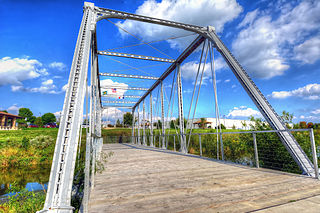
The Dunleith and Dubuque Bridge, also known as the White Water Creek Bridge and the Bergfeld Recreation Area Bridge, is a historic structure located in Dubuque, Iowa, United States. This span was part of a seven-span approach to one of the first bridges constructed over the Mississippi River. It was part of a railroad bridge that connected Dubuque with Dunleith, Illinois, now known as East Dubuque. The bridge was fabricated by the Keystone Bridge Company of Pittsburgh, Pennsylvania. Andrew Carnegie himself traveled to Dubuque to advocate for his company to build the bridge. The bridge was erected by Reynolds, Saulpaugh and Company of Rock Island, Illinois. The approach, of which this iron truss was a part, was completed in 1872. It was used by the Illinois Central and other railroads.






















